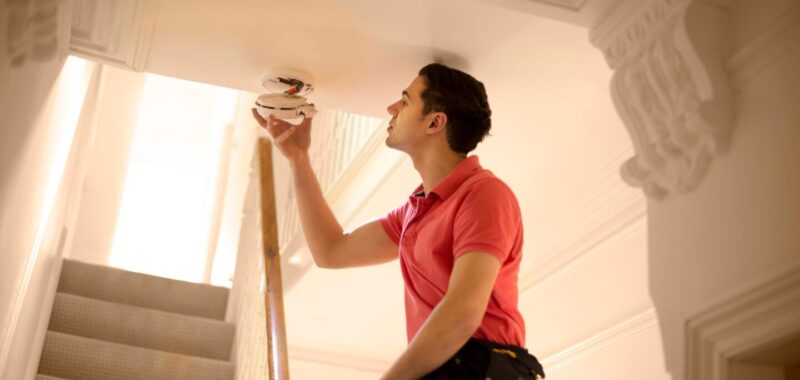Carbon monoxide alarms are small devices that detect carbon monoxide (CO), which is a colorless, odorless gas produced by fuel-burning devices. Carbon monoxide can be deadly when inhaled. When carbon monoxide alarms sense dangerous CO levels, they emit a high-pitched siren, typically four short beeps at a time.
CO alarms attach to walls or ceilings and look similar to smoke alarms. Some devices can detect both smoke and carbon monoxide. Though they’re not required in every state, CO detectors can keep you and your family safe from carbon monoxide poisoning, which is the leading cause of poisoning deaths in America.
Where you install a carbon monoxide alarm can make a big difference in how well the device can detect a potentially deadly level of CO gas. Here are six places to put a carbon monoxide alarm.
1. On each level of the home
Every floor of the home needs a carbon monoxide detector, according to the U.S. Environmental Protection Agency. This includes the basement. It’s especially important to put one on any floor with a fuel-burning appliance.
If you have more than one CO alarm, make sure the devices can interconnect so that one alerted sensor causes the others to sound an alarm. At least one state requires home CO alarms to interconnect.
2. Outside each sleeping area
Carbon monoxide detectors are especially effective when installed directly outside each sleeping area because the symptoms of carbon monoxide poisoning can escalate quickly while you’re sleeping. Ensure the alarm is loud enough to wake you and everyone in the house.
3. Eye level
Carbon monoxide is lighter than air and tends to evenly distribute through a space, though there’s a common misconception that carbon monoxide sinks and is easier to detect closer to the floor.
Though you can place a carbon monoxide detector on the ceiling, installing the device at eye level can make it easier to monitor the status of the device. This also helps keep the alarm out of the reach of children and pets.
4. Near an attached garage
Car exhaust or lawnmower fumes can pose a significant danger if they’re released in a garage attached to your home. Placing a carbon monoxide alarm near the garage door leading into your home — at least 10 feet away, according to home security provider ADT — can alert you to high CO levels leaking into the house from your garage.
If there’s a room above your garage, place a sensor there too.
5. Away from gas-burning appliances
Gas-burning appliances such as stovetops and fireplaces emit small amounts of carbon monoxide, which can cause a false alarm if you place your detector too close to them. Make sure your carbon monoxide alarm is at least 15-20 feet away from sources of CO, including water heaters.
6. Away from high-humidity and dead-air spaces
Areas with a lot of humid air, such as kitchens and bathrooms, can trigger a false CO alarm. Open windows, open doors and spaces with turbulent air, such as near ceiling fans, can also throw off a CO alarm’s ability to properly detect carbon monoxide levels, so place your alarm at least 10 feet away from those spots.

